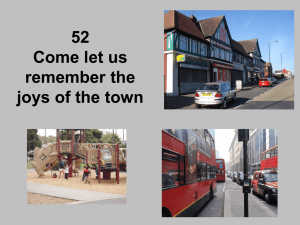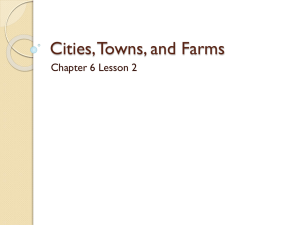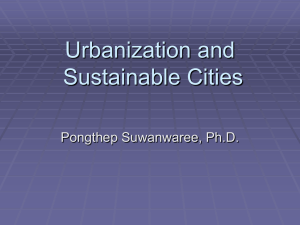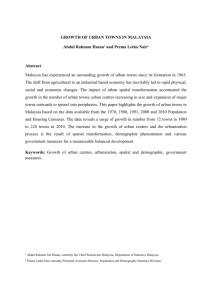New and expanded towns
advertisement
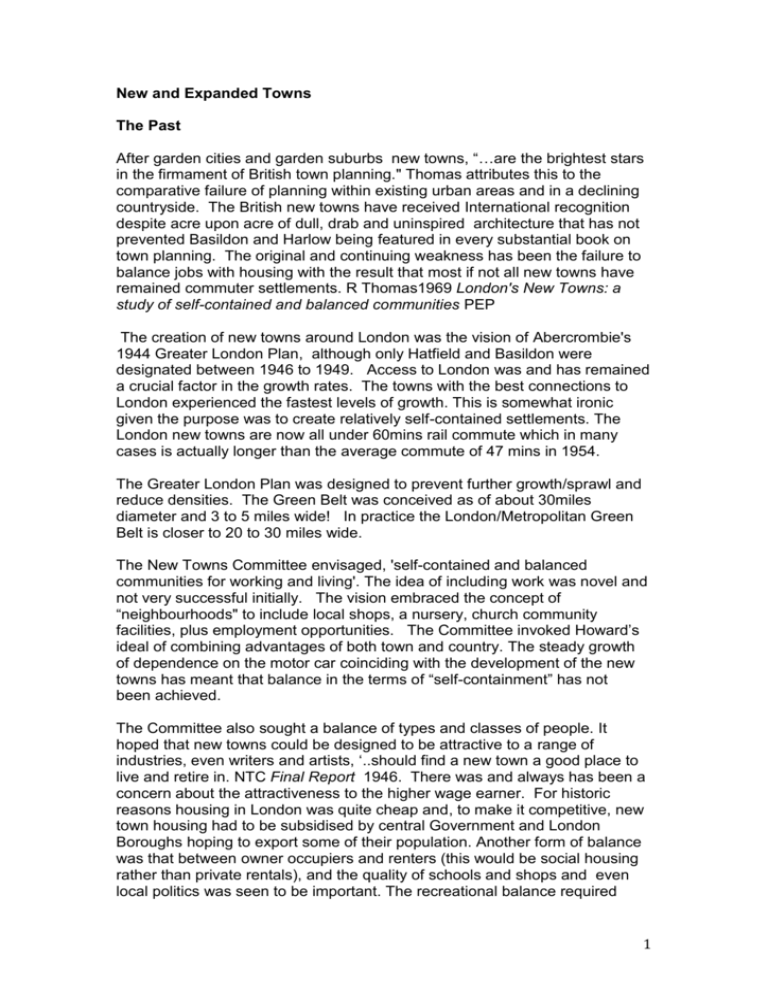
New and Expanded Towns The Past After garden cities and garden suburbs new towns, “…are the brightest stars in the firmament of British town planning." Thomas attributes this to the comparative failure of planning within existing urban areas and in a declining countryside. The British new towns have received International recognition despite acre upon acre of dull, drab and uninspired architecture that has not prevented Basildon and Harlow being featured in every substantial book on town planning. The original and continuing weakness has been the failure to balance jobs with housing with the result that most if not all new towns have remained commuter settlements. R Thomas1969 London's New Towns: a study of self-contained and balanced communities PEP The creation of new towns around London was the vision of Abercrombie's 1944 Greater London Plan, although only Hatfield and Basildon were designated between 1946 to 1949. Access to London was and has remained a crucial factor in the growth rates. The towns with the best connections to London experienced the fastest levels of growth. This is somewhat ironic given the purpose was to create relatively self-contained settlements. The London new towns are now all under 60mins rail commute which in many cases is actually longer than the average commute of 47 mins in 1954. The Greater London Plan was designed to prevent further growth/sprawl and reduce densities. The Green Belt was conceived as of about 30miles diameter and 3 to 5 miles wide! In practice the London/Metropolitan Green Belt is closer to 20 to 30 miles wide. The New Towns Committee envisaged, 'self-contained and balanced communities for working and living'. The idea of including work was novel and not very successful initially. The vision embraced the concept of “neighbourhoods" to include local shops, a nursery, church community facilities, plus employment opportunities. The Committee invoked Howard’s ideal of combining advantages of both town and country. The steady growth of dependence on the motor car coinciding with the development of the new towns has meant that balance in the terms of “self-containment” has not been achieved. The Committee also sought a balance of types and classes of people. It hoped that new towns could be designed to be attractive to a range of industries, even writers and artists, ‘..should find a new town a good place to live and retire in. NTC Final Report 1946. There was and always has been a concern about the attractiveness to the higher wage earner. For historic reasons housing in London was quite cheap and, to make it competitive, new town housing had to be subsidised by central Government and London Boroughs hoping to export some of their population. Another form of balance was that between owner occupiers and renters (this would be social housing rather than private rentals), and the quality of schools and shops and even local politics was seen to be important. The recreational balance required 1 tennis courts as well as football pitches and theatres as well as bingo. Lewis Silkin (first Minister of Town and Country planning) gave a speech at Stevenage in 1950, commending the small groups of dwellings sharing kitchens and other facilities. This was not a level of amenity or privacy that was expected in the rebuilding of post-war London. The Government had been hoping for a level of community ‘blending’ that was being seen as successful at Letchworth and Welwyn. The development of the new towns represented social engineering at the domestic and micro scale but also through Development Corporations using their powers to make housing available to those with local jobs. In the case of housing built for sale, it was only in exceptional cases that a local restriction on occupancy was applied, in which case there was also a first option held by the development corporation to buy these properties back should the owners want to sell. 50 years later this form of control appears antiquated based as it had to be, on some consistent view of a male being the breadwinner and head of household! The new towns were a major component of planning for the London region. The control over the decentralisation of employment was applied through the issue of Industrial Development Certificates for factories over 500 sq ft. IDCs were to be granted first to areas of low employment and then to new towns, although development corporations soon became choosy about which employers to receive. Larger firms found it expedient to work with central government by going directly to the Board of Trade rather than the local development corporations to get priority on housing waiting lists for staff. Registers were kept by London Boroughs of those on their housing waiting lists (together with their skills) and put in touch with firms in new towns. Only if nobody from London was available or expressed an interest could a job vacancy be advertised outside London (under the Industrial Selection Scheme). This extraordinary level of economic and social planning actually accounted for no more than10% of economic migrants. Most of these did move from London, some moving back, but many having broken their traditional ties with London, moved on to other parts of the country. In fact the growth of the new towns was hampered as they became net exporters of population to other parts of the country. Actually, not very different from exiting towns in the region. The movement of population was also a factor in the failure to or delay in creating real communities and social cohesion. Over the years the new towns around London have experienced significant variations in the balance between jobs and housing and commuter patterns back to London, and to other employment centres. It appears that the development of the new towns did represent a decentralisation of population away from some of the inner London boroughs. Over time, as in other parts of the country, levels of home ownership have significantly increased and some of the earliest “right to buy" schemes were devised by development corporations. A list of new towns is included at the end of this module. However, it should be noted that there have been some very important examples of expanded towns (eg Basingstoke and Peterborough) where large numbers of houses 2 have been built. The Future What lessons can we learn from the experience of the 1st 2nd and 3rd waves of new towns? In 2013 all political parties and many NGOs (eg the Town and Country Planning Association) are arguing vociferously for a new programme of garden towns or cities. There has been no letup in the level of commuting into London from the towns located outside its Green Belt. The environmental cost of this scale of commuting is a criticism leveled at Green Belt policy. It is unclear how the development of new settlements would not represent an increase in commuting, particularly in the period while an industrial base was being created. Even a strategy of locating new residential development on the mainline railways has not yet dented the level of commuting by car (research carried out by Peter Headicar at Oxford Brookes University into new housing at Bicester and Didcot). It is possible that the availability of fast broadband enabling work to be carried out at home or in local serviced offices might reduce commuting. However, HS2 - the high-speed rail link proposed between London and the North was described by the then Transport Secretary (Mr Stephen Hammond MP) as changing the country into one travel to work area. While ‘mobility’ rather than ‘access’ is regarded as the objective of spatial planning, new towns will remain an attractive option in the debate about the provision of new housing. It may be a few more years before any significant number of people sign up to a form of low carbon living as would have been the case in Lewis Silkin’s cohousing in 1950’s Stevenage. The original migrants to the new towns were very young in 50s and 60s. These people are now in late old age. The aspirations of that generation and their improved levels of education greatly helped the economic development of the new towns. Although the initial population growth was from predominantly working class areas of London the social balance of the new towns is now close to national average. The new towns share the national problems of under-occupation and finding appropriate housing for small (and many aging) households. The new towns retain an image that suggests a certain rigidity and lack of the opportunities for self expression afforded by areas where growth has occurred in a more haphazard or organic fashion. Anecdotally (opinion polls have shown), the British are more attracted to older forms of housing than those adopted by the volume house-builders, including development corporations, since the war. In this respect new towns are seriously disadvantaged in often having only very small areas of original settlement, and housing mostly on large estates. On the other hand the relatively low densities have allowed for more substantial landscaping in both private gardens and public areas. Trees have been shown to increase the feeling of wellbeing and also property values. 3 In many if not all respects, this course which tries to paint a picture of housing in Britain is a moving target. Houses and residential areas are added to the existing stock at the same time as it is being depleted through demolitions and adapted through redevelopment and infiling. More subtle changes occur through changes in attitudes towards housing, including the ways in which it is valued and used. However, perhaps the most active debate is about how to build 200,000+ new dwellings per year (with a remarkable absence of analysis as to how this level of need is derived). Identifying and meeting housing need will be a continuing theme of the course but one of the main areas of debate revolves around the relative benefits of building new settlements or urban expansions. Eco –towns One of the last initiatives of the Labour Government (1997 – 2010) was to propose a number of eco-towns. In 2009 the Government issued ‘Eco-towns: a supplement to Planning Policy Statement 1 on Planning and Climate Change. Local authorities, landowners and developers were invited to submit proposals directly to the Department of Communities and Local Government. Over 50 proposals were received and a short list of 17 was compiled. One disturbing aspect to this programme was that it was progressing independently from the preparation of Regional Spatial Strategies in accordance with the 2004 Planning Act. The supplement included a very comprehensive list of ecologically sound requirements (that exceed the standards being required of new housing in 2013), including references to the Code for Sustainable Homes and the objective of building 240,000 per year by 2016 when a zero carbon standard would be operative. References were made to the RSSs but this top-down approach would require these plans to adjust to decisions that were being taken at a higher level. Despite the green credentials the programmes was an illustration of the continuing need to putting houses on the ground (with a trendy name) but not as part of regional planning. Although a lower limit of 5000 dwellings was proposed, the programme would have made a relatively small contribution to overall housing needs but could have provided some useful examples of eco-housing at scale. The programme also gave rise to a number of legal challenges, one being on the basis that Government (nominally the Secretary of State) would be the final arbiter of any planning application for an eco-town development when it passes through the statutory processes. It would be detrimental to the consideration of the merits of these proposals if they already had the Government’s blessing. In fact this ‘blessing’ was limited to just 4 proposals. In 2010, the new coalition Government further diluted the concept by requiring only the eco-suburb (being proposed as an extension to the Oxfordshire country town of Bicester to increase the sustainability of the whole town) to meet the exacting standards set out in the eco-town supplement. In 2013, plans for north west Bicester are still being prepared, with the impact on the existing town being very uncertain. Ironically, Bicester had been one of the 4 towns where previous peripheral growth had been demonstrated to be heavily car dependent due to the proximity of the M40 motorway (despite having 2 railway stations). Current state of play The following is a list of the British new towns England Basildon, Bracknell, Central Lancashire , Corby, Harlow, Hatfield ,Hemel Hempstead, Letchworth Garden City, Milton Keynes, ▪ Newton Aycliffe, , Peterlee, Redditch, , Runcorn, Skelmersdale, Stevenage, Telford, , Washington, Welwyn Garden City ▪ Scotland ▪ Cumbernauld, North Lanarkshire, East Kilbride, South Lanarkshire ▪ Glenrothes, Fife, Irvine, North Ayrshire, Livingston, West Lothian Wales ▪ Cwmbran, Monmouthshire The Following towns were expanded on a large scale according to plans brought about from the act. ▪ Crawley, Sussex, England ▪ Northampton, Northamptonshire, England ▪ Peterborough, Cambridgeshire, England ▪ Warrington, Lancashire, England 21st-century New Towns "21st Century New Towns" are being created under the Millennium Communities Programme, which is an act similar to the New Towns Act of 1946. The developments are generally smaller than those created under the New Towns Act. They are also referred to as villages rather than towns, however this is more a marketing strategy than any representation of their size, as the areas are generally part of a large urban backdrop. Some of these projects are merely further development of the new towns created as part of the 1946 New Towns Act. ▪ Greenwich Millennium Village, London ▪ Allerton Bywater Millennium Community, near Leeds ▪ New Islington Millennium Community, Manchester ▪ South Lynn Millennium Community, King’s Lynn ▪ Telford Millennium Community, Telford ▪ Oakgrove Millennium Community, Milton Keynes Hastings Millennium Community, Hastings 5 As they were in at the beginning, I would like to end this module with a reference to the Town and Country Planning Association. In 2011 the TCPA ((supported by developer Land Securities) published Re-imagining garden cities for the 21st century : benefits and lessons in bringing forward comprehensively planned new communities. It points out that it is now over 40 years since the last new town designation and tries to reconcile the concept of new settlements with the localism agenda formally introduced in the 2011 Localism Act and the promotion of neighbourhood planning. It seems highly unlikely that any existing local community would welcome the hundreds and thousands of dwellings implied by a new garden city development that immediately raises the question of whether the need for new settlement is so great that such local opinion should be overruled. If the need was that urgent the difficulties in creating new communities might have to be addressed. However, as an advocate of using new housing as a driver of change, primarily to re-balance existing towns and villages where the level of under-occupation is unjust and unsustainable, and to finance the improved services and facilities in smaller settlements required to make these places more sustainable, I do not think that the case for new garden cities has been made out. 6

